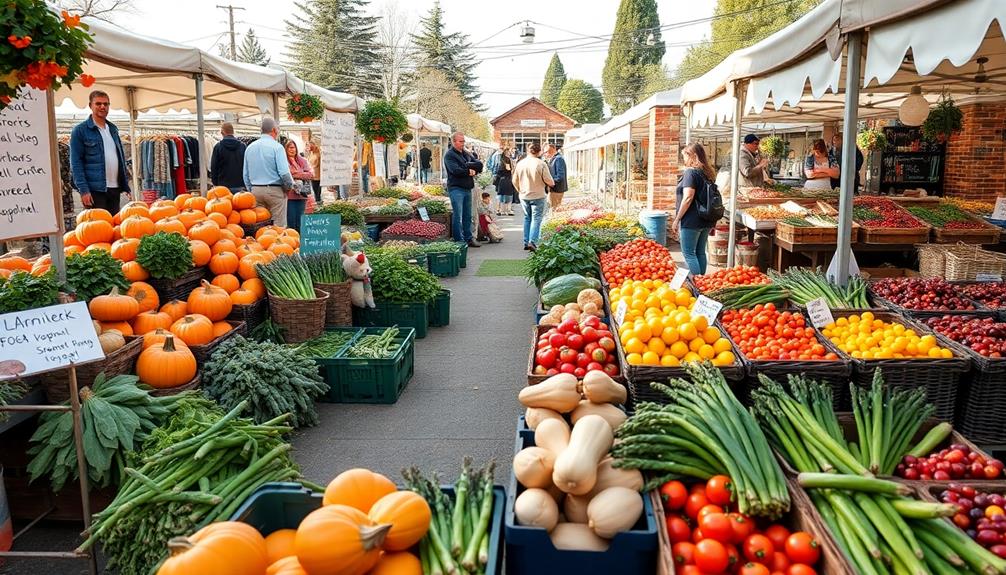Certain foods are linked to seasons because they thrive during specific growth cycles, giving you fresh and nutritious options. Eating seasonal produce means you enjoy ingredients at their peak ripeness and flavor, which enhances your meals. Plus, these foods often contain more vitamins and minerals, supporting your health better. It's not just about taste; seasonal eating helps the environment by cutting down on transportation and supporting local farmers. This connection to nature and community enriches your culinary experience. If you're curious about how seasonal eating can benefit you and your meals, there's more to explore.
Key Takeaways
- Seasonal foods align with natural growth cycles, enhancing flavor and nutrient content at peak maturity.
- Eating seasonal produce supports better digestion and increases vitamin C and antioxidant intake.
- Local and seasonal foods reduce environmental impact by minimizing transportation and resource use.
- Cultural traditions often celebrate seasonal ingredients, connecting communities to their agricultural heritage.
- Seasonal eating encourages culinary experimentation, allowing for diverse and nutritious meal options.
The Science of Seasonal Eating

As the seasons change, so does the variety of fresh foods available to you, creating a natural rhythm in your diet.
Seasonal eating aligns with the natural growth cycles of plants, where specific weather conditions dictate which foods are ripe for harvesting. For instance, springtime brings the opportunity to enjoy dishes like Nettle and Potato Soup, which showcases the vibrant flavors of fresh nettles.
This means you can enjoy seasonal produce like strawberries in spring and tomatoes in summer, ensuring you get the best flavor and nutritional content.
Research shows that fruits and vegetables harvested at their peak maturity accumulate vitamins and minerals more effectively than those grown out of season.
This means that by choosing seasonal options, you're likely enhancing your nutrient intake.
Plus, according to the xenohormesis hypothesis, these plants produce unique compounds in response to their environment, potentially offering additional health benefits when consumed.
Historical Significance of Seasonal Foods

Seasonal foods have shaped human civilization for centuries, influencing not just diets but also cultural practices and celebrations. The historical significance of seasonal foods is evident in how communities have developed traditions around them, with many cultures celebrating harvests through festivals.
For instance, in Indonesia, festive foods like Kue Putu and Nasi Tumpeng often mark significant occasions, highlighting the importance of seasonal ingredients and communal gatherings.
Here are three key aspects you ought to consider:
- Agrarian Practices: Ancient societies depended on seasonal foods to sustain their populations. For example, summer brought grains, while winter was the time for root vegetables, directly affecting food availability.
- Cultural Traditions: Traditional dishes often tie to specific seasons. In many European cultures, spring lamb signifies renewal and fertility, connecting the meal to the lambing season.
- Indigenous Wisdom: Many indigenous cultures maintain a profound relationship with seasonal foods, using plants and animals aligned with their environmental cycles. This practice preserves traditional knowledge and guarantees sustainable living.
Nutritional Advantages of Seasonal Produce

When you choose seasonal produce, you're not just enjoying fresher flavors; you're also boosting your nutrient intake.
Seasonal ingredients, much like Chinese cuisine favorites such as Sichuan cold noodles or red-braised pork belly, often highlight the best of what each season has to offer.
These fruits and vegetables are packed with vitamins, minerals, and fiber, all of which support better digestive health.
Plus, their rich flavors can make your meals not only healthier but also more enjoyable.
Enhanced Nutrient Profiles
Harvesting produce at its peak ripeness brings a wealth of nutritional benefits directly to your plate. When you choose seasonal fruits and vegetables, you're not just enjoying fresh flavors; you're also boosting your health with enhanced nutrient profiles.
For example, incorporating seasonal ingredients like Chilaquiles into your meals can provide additional vitamins and minerals, making your dishes both delicious and nutritious.
Here are a few reasons why seasonal produce is a smart choice:
- Higher Vitamin C Content: In-season strawberries, for instance, pack considerably more vitamin C than those harvested out of season, helping to bolster your immune system.
- Elevated Antioxidants: Seasonal fruits and vegetables often have increased levels of antioxidants, which play an essential role in reducing oxidative stress and inflammation in your body.
- Freshness Matters: Local produce has a shorter time from farm to table, preserving its nutrient content. Leafy greens can lose up to 50% of their vitamin C after prolonged storage.
Optimal Flavor Experience
Choosing fresh, in-season produce not only boosts your health but also elevates your meals with vibrant flavors. When you opt for seasonal fruits and vegetables, you're enjoying them at their peak ripeness, which enhances both their taste and nutritional content.
For instance, in-season tomatoes pack more vitamins A and C, along with antioxidants like lycopene, compared to out-of-season varieties that are often harvested early. Additionally, many traditional Brazilian dishes, such as Caldeirada, highlight the importance of using fresh, seasonal seafood and vegetables to create rich, flavorful meals.
Research shows that produce can lose up to 50% of its vitamin C within a week if not stored properly or transported over long distances. By eating seasonally, you can savor fruits and veggies that are rich in polyphenols and other beneficial compounds, contributing to an ideal flavor experience.
The freshness of seasonal produce not only tantalizes your taste buds but also supports a more enjoyable and nutritious diet. You’ll find that locally grown items, harvested at their peak, offer superior flavors that can transform your meals. Moreover, incorporating seasonal ingredients into your cooking not only enhances the overall dining experience but also promotes sustainability by supporting local farmers. This connection to locality and seasonality allows for unique flavor profiles in your dishes, which can be further enriched by understanding the process of flavor development in aged foods. By blending fresh produce with well-aged ingredients, you can create a symphony of tastes that delights the palate and elevates your culinary creations.
Improved Digestive Health
During warmer months, indulging in seasonal produce can considerably boost your digestive health. By choosing local vegetables and seasonal ingredients, you're not just enjoying fresh flavors; you're also enhancing your gut health. For instance, incorporating dishes that feature seasonal ingredients, like a classic squash casserole made with yellow squash, can provide essential nutrients that support digestion.
Here's why seasonal foods are your best choice:
- Higher Fiber Content: Seasonal produce, like spring greens and summer berries, is often richer in fiber, promoting regular bowel movements and preventing constipation.
- Increased Water Content: In-season fruits and veggies are typically more hydrating, which helps facilitate smoother digestion, especially when the temperatures rise.
- Support for Gut Microbiome: Certain crops, such as fall squashes and root vegetables, are loaded with prebiotics that nourish beneficial gut bacteria, contributing to a healthier microbiome.
Additionally, seasonal foods usually come with lower pesticide residues compared to out-of-season alternatives, making your diet cleaner and gentler on your digestive system.
By embracing these seasonal ingredients, you're aligning your meals with your body's natural rhythms, optimizing both gut health and nutrient absorption.
Environmental Benefits of Eating Seasonally

Eating seasonally offers a simple yet powerful way to reduce your environmental impact. By choosing to follow a seasonal food guide, you're not just enjoying fresh flavors; you're also eating local.
Seasonal crops require less energy and resources to grow and transport, considerably lowering the carbon footprint associated with food. When you support local farmers, you encourage sustainable agricultural practices that promote biodiversity and help preserve critical ecosystems. For instance, including local dishes like Yekolo in your meals can highlight the importance of using regionally sourced ingredients. These ecosystems are essential for maintaining healthy soil and water systems.
Additionally, seasonal foods typically grow naturally, reducing the need for energy-intensive practices like artificial heating and lighting. This responsible land use encourages crop rotation and improves soil health, mitigating the risk of crop diseases.
Moreover, eating in sync with the seasons helps combat food waste. Seasonal produce is harvested at ideal times, minimizing surplus and spoilage that often come with out-of-season imports.
Economic Impact of Local Foods

When you choose local foods, you're not just getting fresh produce; you're also fueling community economic growth.
Seasonal dishes such as Mushroom Masala highlight the importance of using locally sourced ingredients, enhancing both flavor and sustainability.
Every dollar spent on local goods circulates multiple times within your area, creating jobs and supporting sustainable farming practices.
Community Economic Growth
Local seasonal foods play an essential role in boosting community economic growth. When you buy local food, your dollars circulate within the local economy, which helps create jobs and sustain local farms.
Engaging with local food sources, like farmers markets and community-supported agriculture (CSA) programs, strengthens community ties while enhancing economic resilience. Seasonal foods, such as Dorayaki (Red Bean Pancake), not only delight the palate but also encourage the use of local ingredients, further supporting local farmers and producers.
Here are three key benefits of supporting local foods:
- Job Creation: Purchasing from local farmers markets means more money stays in the community, leading to increased employment opportunities.
- Economic Multiplier Effect: Every dollar spent at a local farm or market can generate up to three times that amount in local economic activity, benefiting surrounding businesses and services.
- Direct Sales Opportunities: CSA programs allow farmers to sell directly to consumers, resulting in higher profits than traditional wholesale distribution.
Sustainable Farming Practices
Sustainable farming practices greatly impact both the environment and the economy, creating a win-win situation for communities. By adopting methods like crop rotation and organic farming, local farms enhance soil health and biodiversity, ensuring long-term agricultural productivity.
When you choose to purchase seasonal produce, you're not just enjoying fresh flavors; you're also preserving farmland and open spaces, which can increase property values in rural areas. For instance, enjoying seasonal dishes like Agnolotti can inspire a greater appreciation for local ingredients and the culinary heritage of the region.
Investing in local food systems through community-supported agriculture (CSA) programs allows you to connect directly with farmers, providing them with stable income and fostering a resilient local food economy. With every dollar spent on local food generating approximately $2.50 in economic activity, your support plays a vital role in job creation within the community.
Moreover, reducing reliance on imported foods means lower transportation costs and emissions, resulting in lower grocery prices for you while boosting local economies.
How to Identify Seasonal Ingredients

Identifying seasonal ingredients can enhance your meals and support local agriculture, making it easier to enjoy the freshest flavors throughout the year.
Here's how you can spot in-season produce:
- Research Peak Harvest Times: Different regions have unique harvest schedules. For instance, strawberries are ripe from late spring to early summer, while root vegetables like carrots shine in fall and winter. Knowing these times helps you choose the best food for your meals.
- Visit Farmers Markets: Local farmers markets often showcase seasonal produce prominently. You'll not only find the freshest fruits and vegetables but also connect with farmers who can inform you about what's currently available.
- Use Seasonal Food Charts or Apps: These tools provide valuable insights into when specific ingredients are in season based on your geographical location. This can guide your meal planning and guarantee you're using the best flavors.
Cooking With Seasonal Produce

Cooking with seasonal produce not only elevates your dishes but also connects you to the rhythm of nature. When you choose ingredients that are in season, you tap into their peak freshness, enhancing both flavor and nutrition. Seasonal fruits and vegetables, often harvested at their prime, pack a punch of vitamins, minerals, and antioxidants, making your meals not just tastier but healthier.
Utilizing local seasonal produce can inspire your culinary creativity. You'll find yourself trying new recipes and experimenting with different cooking techniques to showcase the unique flavors of each season.
Plus, by sourcing ingredients grown locally, you support your community's farmers and contribute to a more sustainable food system.
Planning meals around what's currently available also helps reduce food waste. You'll be more mindful about using ingredients before they spoil, which aligns well with a conscious approach to eating.
Seasonal Food and Cultural Traditions

Seasonal food plays an essential role in cultural traditions around the world, with many communities celebrating specific ingredients at various times of the year.
These celebrations often coincide with local harvest cycles, creating a strong connection between the land and the people.
Here are three examples of how seasonal food shapes cultural practices:
- Hanami in Japan: During the cherry blossom season, people gather to enjoy traditional dishes featuring rice and sakura-infused treats, celebrating the beauty of spring and the fleeting nature of life.
- Truffle Festivals in Italy: In autumn, the harvest of truffles sparks regional festivals that showcase this prized delicacy, highlighting its seasonal significance and the local ingredients that define the culinary landscape.
- Winter Solstice Celebrations: Various cultures celebrate the winter solstice with foods like pomegranates and citrus fruits, symbolizing renewal and abundance, which resonate with the themes of hope during the darkest days of the year.
These examples illustrate how seasonal food not only nourishes but also binds communities through shared cultural traditions, honoring the earth's cycles and the local ingredients that sustain them.
Tips for Sustainable Seasonal Eating

Embracing the rhythm of nature through seasonal eating not only honors cultural traditions but also supports sustainable practices. To make the most of seasonal produce, consider these tips:
- Shop Local: Prioritize purchasing seasonal produce from local farmers markets or Community Supported Agriculture (CSA) programs. This reduces transportation emissions and boosts your local economy.
- Stay Informed: Use seasonal food charts or mobile apps to track which fruits and vegetables are currently in season in your region. This helps you make informed choices when shopping.
- Preserve the Harvest: Practice food preservation techniques like freezing, canning, or pickling to extend the enjoyment of seasonal produce and minimize waste.
- Grow Your Own: Experiment with gardening, even in small spaces, to cultivate your own seasonal fruits and vegetables. This enhances your connection to food sources and promotes sustainability.
- Plan Your Meals: Incorporate seasonal meal planning into your routine to create diverse and nutritious meals that align with natural rhythms, optimizing both flavor and health benefits.
| Season | Fruits |
|---|---|
| Spring | Strawberries |
| Summer | Tomatoes |
| Fall | Apples |
| Winter | Citrus fruits |
| Year-Round | Potatoes |
Frequently Asked Questions
Why Are Certain Foods Seasonal?
Certain foods are seasonal because they grow best under specific environmental conditions. You'll notice that temperature, moisture, and daylight influence when crops thrive, which leads to their availability at different times of the year.
What Are the Foods We Eat in Different Seasons?
In spring, you'll enjoy asparagus and strawberries. Summer's ripe tomatoes and berries delight your palate. Fall brings pumpkins and apples, while winter's root vegetables and citrus keep you nourished and satisfied during the colder months.
How Do Seasons Affect Food?
Seasons are nature's rhythm, dictating what's fresh and vibrant. They shape your meals, as temperature and rainfall influence crop growth. Eating seasonally connects you to agriculture, ensuring your plate's filled with flavorful, nutrient-rich produce.
How Is the Meal According to a Season?
You'll find meals vary with the seasons, as fresh ingredients peak at different times. In spring, you'll enjoy lighter dishes; summer brings vibrant flavors; fall offers hearty comfort, while winter favors warm, nourishing options.
Conclusion
Embracing seasonal foods isn't just a trend; it's a bridge between our past and present. While you might crave strawberries in winter, savoring them in summer offers vibrant flavors and peak nutrition. Just as nature's rhythm dictates growth, your choices can enhance your health and support local farmers. So, swap out out-of-season imports for fresh, local produce—your taste buds, wallet, and the planet will thank you. Eating seasonally isn't just smart; it's deliciously rewarding.










